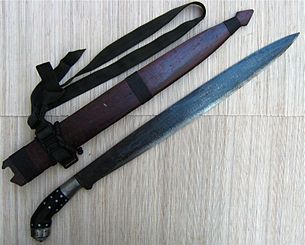- Dahong Palay
-
Dahong Palay Type Close combat weapon Place of origin Philippines Specifications Length 18-30 in. (45-75 cm) Blade type Normal blade pattern Hilt type Full tang Scabbard/sheath Wood Haft type Wood The Dahong Palay (also sometimes spelled Dahon palay or Dahompalay), literally 'Rice Leaf' in Tagalog, is a single-edged sword from the Philippines, specifically the Southern Tagalog provinces of Batangas and Mindoro. The sword's name could either be a reference to the similarity of its shape to the leaves of rice or to local green snakes "dahong palay", purported to be extremely venomous.[1][2] The snake is probably green specimens of the Philippine Pit Viper, Trimeresurus flavomaculatus,[3][4] though it is sometimes identified as various relatively harmless green snakes, like vine snakes.[5] The dahong palay was originally used as a farmer's tool, for clearing thick grass growths. However, during the Philippine revolution of 1896, farmers from Batangas soon came to favor it for its slashing and thrusting "feel".[6]
Contents
Physical description
The dahong palay's size is about the same as most Filipino swords such as the kalis, golok, or ginunting, measuring about twenty to thirty inches.
Blade
The blade is single-edged and has what is classified as a normal blade pattern – that is, it has a curved cutting edge, and a back which is virtually flat at the tip.
The width of the blade is at its fullest at the hand guard, and from there the sharp edge tapers smoothly, with only the slightest curve or "belly" as it moves towards the tip of the sword. In contrast, the back of the blade only begins to curve downward as it nears the hilt, which in turn also curves downwards, completing the "rice leaf" tapering profile of the sword.
The tip of this "rice leaf" profile is an acute and very sharp point, which gives the blade its penetrating capability when used in a thrusting motion. The balance and steep profile of the sword, in turn, gives it its cutting ability when used in a slashing motion.
Hilt
The sword's full tang is embedded in a long hilt, traditionally made of Kamagong wood. As previously explained, this hilt tilts downwards, contributing to the sword's unique profile. Aside from that, however, the exact shape of the hilt, varies significantly from piece to piece, with the pommel and grip not always distinct parts of the hilt, and a crossguard that isn't present in all pieces. In addition, the dahong palay's origins as an agricultural tool means that the hilts are often simple and practical, rather than ornate as is often the case in the kalis or kampilan.
In history
As a weapon, the dahong palay was a mainstay during the many conflicts that have plagued the Southern Tagalog region since its first use during the Philippine revolution against the Spanish – used by farmer-warriors whenever they could not acquire firearms. It is noted for having been used by Filipino guerrillas in the region during World War II.
See also
References
- ^ Dahong Palay by Arturo B. Rotor
- ^ Manuel Sastrón (1895). "Filipinas: Pequeños Estudios; Batangas Y Su Provincia". Estab. tipo-lit. delAsilo de huérfanos. http://www.archive.org/details/filipinaspequeo02sastgoog. Retrieved 9 January 2011.
- ^ Dong Ampil de los Reyes (March 24, 2008). "Stuck with rice". http://kulamnista.blogspot.com/. http://kulamnista.blogspot.com/2008_03_01_archive.html. Retrieved 9 January 2011.
- ^ "Pinoywood Central Casting". http://pinoywood.wordpress.com/.+February 12, 2010. http://pinoywood.wordpress.com/2010/02/12/4/. Retrieved 9 January 2011.
- ^ Gerry S. Rubio. "Study on snakes, its ecosystem, is best CSC undergrad research". http://www.csc.edu.ph. http://www.csc.edu.ph/news/032010/pisog_awardees.htm. Retrieved 9 January 2011.
- ^ "Dahon Palay". http://www.traditionalfilipinoweapons.com/DahonPalay.html. Retrieved 2009-02-01.
Categories:- Southeast Asian swords
- Philippine martial arts
- Malayan swords
- World War II infantry weapons
- Weapons of the Philippines
Wikimedia Foundation. 2010.

